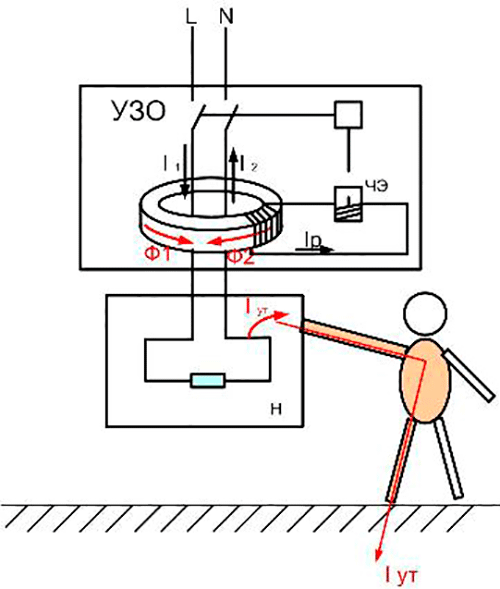People who understand the principles of electrical circuits, it is known that automatic switches, triggered by the short-circuit current and overload on a "minor" leak not responding. For a man the same shock due to the leakage at a voltage of 220 volts can have serious consequences. Theoretically, with this the snow cock through the human body can pass the current value 220 mA. In the literature on safety and labor protection value of 100 mA is indicated as capable of causing death, so even theoretically 220 mA is a very serious danger.To prevent such dangerous leaks of the RCD compares the amount of the passing to consumers of the current value of the reverse current, and when exceeding the set parameters almost instantly opens the circuit.
Residual current device consists of: a ferromagnetic core with 3 windings. Through the coil flows a current given to the consumers, goes through the second reverse current. Under normal condition the value of the resulting current, must equal the value of the current flowing, the induced currents to these magnetic fields compensate each other, and the total flux is zero. If the sum of passing currents exceeds the allowable value, the magnetic flux starts to affect a third control winding, forming in it an induced electromotive force, which acts on the relay's normally closed circuit. Modern RCD in addition to the core and windings contain other electronic components, but the principle of operation is the basis for the operation of protective devices.
UZO are single-phase and three-phase, voltage-dependent power – electronic and independent of it – Electromechanical. Additionally, the devices are divided into 5 types according to the operating conditions.
Type AC. The RCD reacts to the alternating sinusoidal differential current, which may grow slowly or appear suddenly.
Type A. residual current Device responds to alternating and direct pulsating differential current, which can appear suddenly or slowly increase.
Type V. the Device responds to AC, DC and rectified differential current.
Type S and G. the RCD has a shutter at the turn-off time.
In Russia are mainly used ouzo for installation in switchboard on DIN rail, built-in RCD is not widespread received.
The principle of operation
Residual current device consists of: a ferromagnetic core with 3 windings. Through the coil flows a current given to the consumers, goes through the second reverse current. Under normal condition the value of the resulting current, must equal the value of the current flowing, the induced currents to these magnetic fields compensate each other, and the total flux is zero. If the sum of passing currents exceeds the allowable value, the magnetic flux starts to affect a third control winding, forming in it an induced electromotive force, which acts on the relay's normally closed circuit. Modern RCD in addition to the core and windings contain other electronic components, but the principle of operation is the basis for the operation of protective devices.
Main types of RCD
UZO are single-phase and three-phase, voltage-dependent power – electronic and independent of it – Electromechanical. Additionally, the devices are divided into 5 types according to the operating conditions.
Since the 1980-ies, in the USA most of the household RCD began to build in the socket.
Type AC. The RCD reacts to the alternating sinusoidal differential current, which may grow slowly or appear suddenly.
Type A. residual current Device responds to alternating and direct pulsating differential current, which can appear suddenly or slowly increase.
Type V. the Device responds to AC, DC and rectified differential current.
Type S and G. the RCD has a shutter at the turn-off time.

